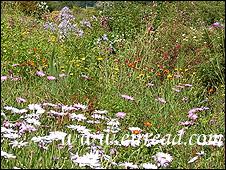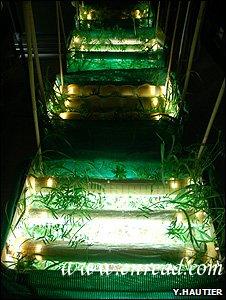| ||||||||||||||||||||||||||||||||||||||||||||||||||||||||||||||||||||||||||||||||||||||||
|
Scientists have identified why excessive fertilisation of soils is resulting in a loss of plant diversity. 科学家已经鉴定出为什么土壤过度的肥沃会使植物的多样性消失。 Excess nutrients2 have been found to have an adverse3 impact on diversity Extra nutrients allow fast growing plants to dominate a habitat, blocking smaller species' access to vital(至关重要的) sunlight, researchers have found. As a result, many species are disappearing from affected4 areas. A team from the University of Zurich, writing in Science, warned that tighter controls were needed in order to prevent widespread biodiversity(生物品种) loss. Estimates suggest that the global level of nitrogen(氮) and phosphorous(磷的) available to plants has doubled in the past 50 years. Looking at grasslands5, the researchers said it was widely recognised that an increase of chemical nutrients in an ecosystem6(生态系统) led to a loss of diversity, but the mechanism7 of how it was occurring had been difficult to determine. "You would think that more [nutrients] would lead to more biodiversity," said co-author Andrew Hector, a researcher at the University of Zurich's Institute of Environmental Sciences. "Yet it is considered to be one of the main threats to biodiversity this century." The study showed that understory lighting8 halted plant diversity loss 'Winner takes all' Professor Hector explained that there were two main hypotheses: "One is that the presence of more resources led to a general increase in the strength of competition among plants. "The other is a little bit more mechanistic(机械论的)," he told BBC News. "When you get an increase in fertilisation, you get an increase in productivity, leading to increased plant biomass(生物量) and increased shading. "This shifts the idea to light being the critical resource, with shorter species being shaded out by taller species, resulting in a loss in diversity." Professor Hector's team, led by PhD student Yann Hautier, fitted lights to the understory(林下叶层) of grass in boxes containing fertilised soil. "Additional understory light compensated9(补偿) for the increased shading caused by the greater above-ground biomass production," they explained. The supplementary10 light "prevented the loss of species and maintained… levels of diversity". The findings led the team to conclude that it was the lack of access to light that affects diversity, not an increase in the strength of competition. "We have done the critical experiment that has been asking to be done for the past 35 years," said Professor Hector. "If it all depends on light levels, then if you put the light back then you should prevent a loss of biodiversity." However, he added that their findings did not offer a "magic bullet" for conservationists. "What our research shows is that competition for light is very asymmetric11(不对称的). "So if a plant can get between the sun and its competitors, not only can it get all the light it needs but it can also block its competitors' access to light. "Because this competition for light is such a 'winner takes all', it emphasises how important it is that we control nutrient1 enrichment." 点击  收听单词发音 收听单词发音
|
||||||||||||||||||||||||||||||||||||||||||||||||||||||||||||||||||||||||||||||||||||||||
- 发表评论
-
- 最新评论 进入详细评论页>>





